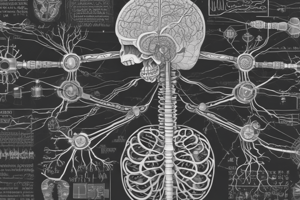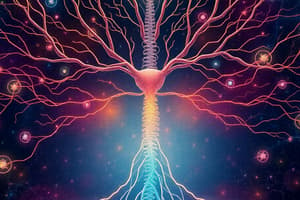Podcast
Questions and Answers
What is the primary function of the limbic system within the brain?
What is the primary function of the limbic system within the brain?
Which of the following accurately describes the role of the hippocampus?
Which of the following accurately describes the role of the hippocampus?
What component of the nervous system is primarily responsible for involuntary processes?
What component of the nervous system is primarily responsible for involuntary processes?
Which subdivision of the nervous system is responsible for voluntary movements?
Which subdivision of the nervous system is responsible for voluntary movements?
Signup and view all the answers
Which nervous system component serves as a conduit for nerve signals between the brain and the rest of the body?
Which nervous system component serves as a conduit for nerve signals between the brain and the rest of the body?
Signup and view all the answers
What characterizes hypothermia?
What characterizes hypothermia?
Signup and view all the answers
What is the primary function of nociceptors?
What is the primary function of nociceptors?
Signup and view all the answers
Nociceptors are associated with which type of nerve fibers?
Nociceptors are associated with which type of nerve fibers?
Signup and view all the answers
Which characteristic of nociceptors allows them to respond to a variety of harmful stimuli?
Which characteristic of nociceptors allows them to respond to a variety of harmful stimuli?
Signup and view all the answers
How do nociceptors respond to prolonged exposure to a noxious stimulus?
How do nociceptors respond to prolonged exposure to a noxious stimulus?
Signup and view all the answers
Which of the following correctly describes the role of selective attention?
Which of the following correctly describes the role of selective attention?
Signup and view all the answers
What is the primary function of the axon in a neuron?
What is the primary function of the axon in a neuron?
Signup and view all the answers
Which component of a neuron is responsible for receiving signals from other neurons?
Which component of a neuron is responsible for receiving signals from other neurons?
Signup and view all the answers
What is meant by cognitive flexibility in the context of executive functions?
What is meant by cognitive flexibility in the context of executive functions?
Signup and view all the answers
Which of the following best describes creativity?
Which of the following best describes creativity?
Signup and view all the answers
What is the primary role of myelin in the nervous system?
What is the primary role of myelin in the nervous system?
Signup and view all the answers
Which types of attention are categorized under the broader concept of attention?
Which types of attention are categorized under the broader concept of attention?
Signup and view all the answers
What is the primary function of white matter in the spinal cord?
What is the primary function of white matter in the spinal cord?
Signup and view all the answers
Which structure is formed by the emergence of pairs of spinal nerves?
Which structure is formed by the emergence of pairs of spinal nerves?
Signup and view all the answers
What role do interneurons play in reflex arcs?
What role do interneurons play in reflex arcs?
Signup and view all the answers
Which lobe of the cerebrum is primarily responsible for auditory processing?
Which lobe of the cerebrum is primarily responsible for auditory processing?
Signup and view all the answers
What is the main role of the cerebellum?
What is the main role of the cerebellum?
Signup and view all the answers
Which function is NOT attributed to the frontal lobe?
Which function is NOT attributed to the frontal lobe?
Signup and view all the answers
Which component of the brain is known as the 'Command Central'?
Which component of the brain is known as the 'Command Central'?
Signup and view all the answers
Which aspect of sensory information is processed by the parietal lobe?
Which aspect of sensory information is processed by the parietal lobe?
Signup and view all the answers
What type of response is represented by reflexes mediated by the spinal cord?
What type of response is represented by reflexes mediated by the spinal cord?
Signup and view all the answers
What is the primary feature that distinguishes white matter from gray matter within the spinal cord?
What is the primary feature that distinguishes white matter from gray matter within the spinal cord?
Signup and view all the answers
Perceiving size and depth is crucial for effective visual interfaces.
Perceiving size and depth is crucial for effective visual interfaces.
Signup and view all the answers
Brightness and color have no impact on visual interface design.
Brightness and color have no impact on visual interface design.
Signup and view all the answers
Visual perception includes the elements of size, depth, brightness, and color.
Visual perception includes the elements of size, depth, brightness, and color.
Signup and view all the answers
Standing on a hilltop would not affect your perception of size and depth.
Standing on a hilltop would not affect your perception of size and depth.
Signup and view all the answers
Effective visual interfaces do not consider user perception.
Effective visual interfaces do not consider user perception.
Signup and view all the answers
Study Notes
Nervous System
-
The Nervous System is divided into two main components: the Central Nervous System (CNS) and the Peripheral Nervous System (PNS).
-
The CNS controls all body functions, while the PNS connects the CNS to the rest of the body.
-
The CNS is composed of the brain and spinal cord, while the PNS is comprised of nerves, ganglia, and sensory receptors.
Limbic System
- The limbic system is a complex network of structures located deep within the brain.
- It is responsible for emotions, memory, and motivation.
- Key structures include the hippocampus and amygdala.
Hippocampus
- The hippocampus is crucial for memory formation and consolidation, particularly spatial and declarative memories.
- It also contributes to navigation and cognitive mapping.
Amygdala
- The amygdala is an almond-shaped structure involved in processing emotions, particularly fear and anxiety.
- It plays a role in emotional learning, memory consolidation, and decision-making.
Attention
- Attention allows us to focus on specific stimuli or tasks while ignoring irrelevant ones.
- Different types of attention include selective, sustained, and divided attention.
Executive Functions
- Executive functions are higher-level cognitive processes that enable goal-directed behavior, planning, decision-making, and self-regulation.
- They include abilities like inhibition, working memory, cognitive flexibility, and problem-solving.
Creativity
- Creativity involves generating novel ideas, solutions, or products that are original and valuable.
- It is linked to divergent thinking, the ability to think outside the box, and the willingness to take risks.
Neurons and Associated Cells
- Neurons are specialized cells that transmit nerve impulses and communicate with other cells.
- They have a cell body (soma), dendrites, an axon, and an axon terminal.
Cell Body (Soma)
- The cell body contains the nucleus and organelles necessary for cellular functions.
Dendrites
- Dendrites are branching extensions of the cell body that receive incoming signals from other neurons or sensory receptors.
Axon
- The axon is a long, slender projection that carries nerve impulses away from the cell body towards other neurons or effector cells.
Axon Terminal
- The axon terminal is the end of the axon that forms synapses with other cells, allowing for communication via neurotransmitters.
Myelin Sheath
- Some axons are surrounded by a myelin sheath, a fatty insulation that increases the speed of nerve impulse conduction.
Schwann Cells and Oligodendrocytes
- These are glial cells that produce myelin in the peripheral nervous system (Schwann cells) and central nervous system (Oligodendrocytes), respectively.
- They provide support and insulation for neurons.
Generation and Propagation of Nerve Impulses
- Nerve impulses, or action potentials, are electrical signals that travel along the axons of neurons.
White Matter
- White matter is organized into ascending tracts (sensory pathways carrying information to the brain) and descending tracts (motor pathways carrying commands from the brain to the spinal cord).
Spinal Nerves
- At regular intervals along the spinal cord, pairs of spinal nerves emerge through openings called intervertebral foramina.
- Each spinal nerve contains sensory and motor fibers, innervating specific regions of the body known as dermatomes.
Reflex Arcs
- The spinal cord mediates reflexes, rapid involuntary responses to stimuli.
- Reflex arcs involve sensory neurons detecting a stimulus, interneurons in the spinal cord processing this input, and motor neurons transmitting a response to muscles or glands.
The Brain
-
The brain is the "Command Central" of the body, regulating physiological and cognitive processes.
-
Its most complex organ, responsible for controlling behavior, interpreting sensory input, processing emotions, and coordinating voluntary and involuntary movements.
Cerebrum
- The cerebrum is the largest part of the brain, divided into two hemispheres, each with four main lobes: frontal, parietal, temporal, and occipital.
Frontal Lobe
- The frontal lobe controls higher cognitive functions like decision-making, planning, reasoning, and voluntary muscle movement.
Parietal Lobe
- The parietal lobe processes sensory information related to touch, temperature, pain, and spatial awareness.
Temporal Lobe
- The temporal lobe is involved in auditory processing, memory formation, and language comprehension.
Occipital Lobe
- The occipital lobe processes visual information and interprets visual stimuli.
Cerebellum
- The cerebellum is located below the cerebrum and behind the brainstem, consisting of two hemispheres.
Hypothermia
- Inadequate thermoregulation or exposure to cold environments can lead to hypothermia, characterized by abnormally low body temperature.
- Hypothermia impairs physiological function and can lead to complications such as frostbite, hypothermia-related injuries, and death if left untreated.
Nociceptors
- Nociceptors are specialized sensory receptors that respond to noxious or potentially harmful stimuli, such as tissue damage and extreme temperatures.
- They are primarily responsible for the perception of pain and initiation of protective reflexes to avoid or minimize tissue injury.
- Nociceptors are distributed throughout the body.
Characteristics of Nociceptors
- High Threshold: Nociceptors require strong stimuli to generate a response, ensuring they primarily respond to potential tissue damage.
- Polymodal Sensitivity: They can respond to a wide range of noxious stimuli, including mechanical, thermal, and chemical stimuli.
- Unmyelinated or Lightly Myelinated Fibers: Nociceptors are associated with thinly myelinated or unmyelinated fibers that transmit nociceptive signals to the CNS.
- Adaptation: They show little adaptation to sustained or repetitive stimulation, providing continuous feedback about ongoing tissue damage.
- Convergence and Divergence: Multiple nociceptors can converge onto a single neuron in the spinal cord, while a single nociceptor can receive input from multiple sources.
Types of Nociceptors
- Mechanical: Respond to pressure, stretching, or tissue damage.
- Thermal: Respond to extreme temperatures, both hot and cold.
- Chemical: Respond to chemical irritants or inflammatory mediators released during tissue injury.
Functions of Nociceptors
- Pain Sensation: Nociceptors detect and transmit pain signals to the CNS in response to noxious stimuli.
- Protective Reflexes: Nociceptor activation initiates protective reflexes aimed at avoiding or minimizing tissue injury.
Perceiving Size and Depth
- Our perception of size and depth is influenced by distance.
- Objects of the same size appear smaller as they are further away.
Perceiving Brightness
- Brightness is a subjective interpretation of light levels.
- It is not a purely objective measurement.
Studying That Suits You
Use AI to generate personalized quizzes and flashcards to suit your learning preferences.
Description
Test your understanding of the nervous system components, including the Central and Peripheral Nervous Systems, as well as the limbic system's role in emotions and memory. Explore key structures such as the hippocampus and amygdala and their functions in cognition and emotional processing.





